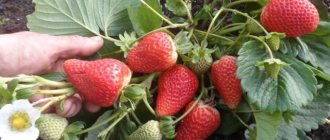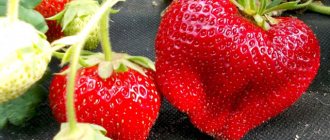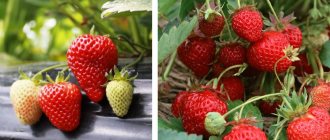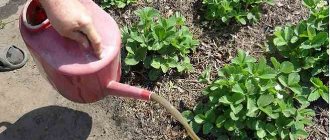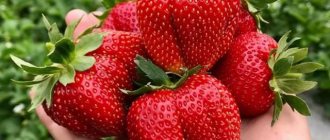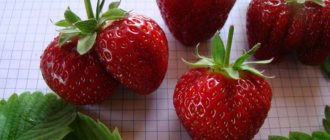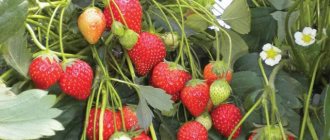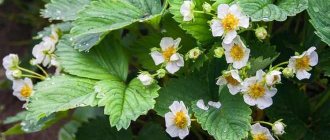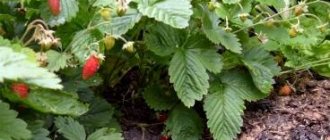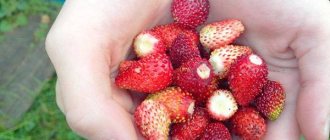Description of the variety
Tsarina is a universal variety of medium-ripening strawberries, included in the State Register for the Central Region in 2009. The variety was obtained by the famous breeder S. Aitzhanova on the basis of the Kokinsky stronghold of the Institute of Horticulture and Nursery Growing. Valued for increased drought resistance and excellent transportability of berries.
Bushes
The queen is characterized by semi-spreading medium-sized bushes with medium leaves. The leaf blades are large with jagged edges, green, concave, without pubescence. The flowers are large, white in color, collected in small inflorescences. The flowers are bisexual and do not require additional pollination. The peduncles are of medium length, located below the leaves, and can lie down under the weight of the berries. Educational ability is average. The mustache is pale red and of medium thickness.
Berries
On average, each plant bears from 10 to 15 berries weighing about 40 g. The berries of the Queen are wide-conical in shape, rich red in color, and shiny. The pulp is dense, the crop can be transported over long distances. The tasting score of the berries is high (4.8 points), the aroma of wild strawberries. The fruits do not rot even during prolonged rainy weather.
During harvesting, the berries are well separated from the stalk, which prevents further damage. Thanks to the dense pulp, the fruits retain their shape when defrosted after freezing.
Productivity
The mass harvest of berries from the Tsaritsa variety occurs at the end of June. By the end of fruiting, significant shrinkage of the fruits is observed. The mass of the last berries usually does not exceed 15-25 g. On average, from one well-developed plant during the growing season you can get from 500 to 700 g of berries (100-130 c/ha). For industrial scale, these are average values, so the variety is mainly used for amateur breeding.
Productivity
Bushes of this strawberry variety reach their highest yield in the second or third season after planting the seedlings. In the 4th season, the berries begin to become smaller, so it is advisable to change the location of this strawberry plantation every 4 years.
From one Tsaritsa strawberry bush, 400 to 800 g of ripe berries are collected; with good care, up to 1 kg of ripe produce is collected from each plant. When growing this berry crop on an industrial scale, from 100 to 125 centners of strawberries are harvested from each hectare.
Strawberry Queen 2021 - video
a brief description of
Like any other strawberry, the Tsarina has its advantages and disadvantages.
Advantages of the variety
- increased drought and heat resistance;
- high resistance to fungal diseases;
- ease of care;
- high resistance to ticks;
- sweet, aromatic fruits.
Disadvantages of the variety
Among the shortcomings of the Queen, low frost resistance can be noted. At a temperature of -15C, generative buds can be damaged.
Suitable region and climate
The plant demonstrates excellent productive qualities in the Bryansk, Vladimir, Ivanovo, Moscow, Ryazan, Tula, Smolensk and Kaluga regions. According to reviews from gardeners, there is positive experience of growing in the Moscow region, Siberia, Belarus, Ukraine and Poland. Such a climatic range is possible due to the good frost resistance of the variety, the ability of the plant to develop and bear fruit in conditions of short daylight hours, in hot, rainy weather.
Landing
The landing of the Queen must be carried out in compliance with certain rules. You should be especially careful when choosing a place for growing. For planting, it is necessary to choose open, well-lit areas without close (less than 1 m) groundwater. The preferred soil is fertile loam with an acidity of pH 5.2-5.5. Alkaline, swampy and clayey soils are unsuitable for growing strawberries.
Strawberry plantations should not be located next to trees. Their well-branched root system absorbs large amounts of moisture. The best precursors for growing strawberries are various types of legumes, greens, radishes, and celery (dill, parsley, carrots).
Strawberry seedlings are planted using the row method. In this case, either one or two-line landing can be used. There should be an interval of 20-30 cm between plants, and 40-70 cm between rows.
It is better to mark out future rows in advance. To do this, pegs are driven in and a cord is pulled between them. This will allow you to achieve an even and neat planting, which will greatly facilitate the maintenance process. Strawberries can also be planted using black non-woven material. It will eliminate frequent weeding and significantly reduce the number of waterings, however, on heavy soils it can lead to the development of root rot.
It is better to plant Tsaritsa strawberries in the spring (late April - early May) or in the summer-autumn (late July - early August). You can plant the mustache later, however, the plant will not have time to develop before winter and you can’t expect a harvest next year.
Necessary conditions for strawberry growth
The variety is distinguished by its unpretentiousness, rapid establishment and rapid development. All this happens thanks to long daylight hours and active processes in the soil. In autumn, the number of daylight hours decreases, which entails a decrease in the activity of microorganisms in the soil. Because of this, experts do not recommend planting strawberries in autumn days.
Climate and growing region
When breeding Tsarina strawberries, the harsh Russian climate was taken into account, which gave the plant excellent resistance to cold and temperature changes. Strawberries grow best in a temperate continental climate, which is typical for Belarus, Ukraine, and Russia. Cultivation is allowed in the southern and northern parts of the country.
Suitable soil
The soil should be slightly acidic, sandy, light. It is not allowed to plant berries with nearby groundwater. The area should be well lit and warmed by the sun.
Predecessors and neighbors
The best predecessors of strawberries are plants like radishes, parsley, spinach, and mustard. Strawberry plantings can be made at the previous location of hyacinths, tulips, and daffodils.
You can plant strawberries next to root parsley - it is an excellent neighbor.
Next to it, the berry will be protected from slugs and snails. Good neighbors are carrots, onions, garlic, radishes or radishes. It is advisable that plants planted nearby bear fruit at the same time as the strawberries.
Care
Caring for Tsaritsa strawberries involves timely watering, weeding and fertilizing.
Top dressing
The first time fertilizer is applied immediately after the snow melts. For this purpose, nitrogen-containing mixtures are used. For example, urea, azofoska or humus (bucket per m2). Their main purpose is to stimulate the regrowth of leaf mass. The strawberries are fed the second time before budding begins. During this period, phosphorus-potassium fertilizers are used, for example, wood ash (200 g per m2). The last time fertilizing is used is at the end of summer. You can use complex fertilizer “Autumn”, which contains a small amount of nitrogen.
One of the options for feeding strawberries: applying organic-mineral fertilizer (OMF) for strawberries and wild strawberries in the spring from Buysky chemical. plant + several (2-3) foliar feedings with Novalon Foliar 9-12-40
Removing a mustache
When growing Tsarina strawberries, it is necessary to periodically remove the growing mustache. If this is not done, the plantation becomes thickened, which leads to smaller berries and a decrease in yield. It’s even better to separate the plants that are used to produce berries and the bushes from which you need to get tendrils (mother plants). Flower stalks are removed from the queen cells and additionally fed with fertilizers with a high nitrogen content. From one mother bush you can get up to 50 seedlings, the average value is 10-12 pieces.
Growing rules
To successfully grow a variety, it is important to follow the planting and care rules developed by breeders. First, you should carefully select a site for your strawberry bed. For her they reserve:
- flat, well-windowed and sunny area;
- the most open place (for this, tall plants are not planted approximately 10 meters from the strawberries, buildings and barriers are not placed).
In some cases, a site with a slight slope is acceptable, but it is important to ensure that water does not stagnate at the roots. If you plant a berry in a low, swampy place, it will definitely get sick and produce a weak, small harvest.
The soil
Light loamy soil with nutrients is best suited:
- on clay and heavy soils, the plant will need to be drained - it is important to add coarse sand before digging;
- on sandy soils you will need at least a bucket of rotted cow manure, a glass of wood ash and 60 g of urea per 1 square meter. meter of area.
These components can be added to the soil during the autumn digging of the beds. If necessary, a deoxidizing agent is also added to the soil.
According to gardeners, the best soil for growing strawberries is light loamy soil with nutrients.
Landing
In the spring, coverings and dead parts of plants are cleared from old strawberry plantings, then the soil around the bushes is loosened and fertilizing is applied.
Seedlings prepared for new plantings are planted in April or September. But April plantings are more reliable, since the seedlings take root faster and immediately begin to noticeably grow.
Spring planting of strawberries is more reliable due to better survival rate
Plants are planted in loose soil well seasoned with humus and nitrogen-mineral fertilizers. Sequencing:
- Make separate holes or grooves to the depth of the roots of the seedlings.
- Be sure to spread the roots of the seedlings in different directions.
- Sprinkle the bush with soil (a necessary condition is that the central bud cannot be covered, it is located just above ground level).
- Water the bush immediately and carefully (it is better to do this in small portions, distributing the water around the plant).
- Carry out mulching (to do this, use dry grass, straw or sawdust in a layer of up to 5 cm).
To protect plantings from bird invasion, you can cover them with agrofibre (spunbond), but more reliably - with mesh. Then, during the rains, the berries and bushes will not remain under cover for a long time and will not rot.
Video: planting tips
How to choose seedlings
Why are experienced breeders convinced that only the correct choice of planting material will help achieve the expected results from cultivation? Because many diseases and pests are brought to our garden plots with purchased seedlings.
The author of the garden strawberry variety Tsarina Svetlana Aitzhanova recommends taking seedlings only:
- in breeding research centers with constant monitoring of seedlings;
- in nurseries where professional biotechnologists work on reproduction (in sterile conditions, using modern methods).
Only in these cases can one vouch for their purity. Such selection centers and stations operate in Moscow (at the Russian State Agrarian University named after K.A. Timiryazev), Orel, Tula, Michurinsk, Tambov region and others.
Strawberry seedlings are necessarily sold in separate containers, with a tightly protected root system. These conditions, when planted in a permanent place, give a survival rate of 100%.
An important clarification: when purchasing seedlings in a pot, you should inspect the roots - they should be evenly distributed throughout the container. If seedlings are sold in peat containers, strong and healthy roots are usually visible as they come out through the walls.
Planting material is of great importance for the health of strawberry bushes
Proper watering
Despite its known resistance to extreme heat, the Tsaritsa variety requires abundant watering for increased yield. In especially dry southern and southeastern regions of Russia, it is recommended to install a drip irrigation system.
Strawberries of the Tsaritsa variety require abundant, precisely controlled watering.
In the southern and central regions, if hot weather sets in for more than half a month, strawberries will require regular, abundant watering (20 liters of water for one large bush, no more than once a week). This amount of water will completely saturate the soil and wet it up to 30 cm deep. This is exactly how much space a well-grown root system takes up. This is especially important:
- during the period of abundant flowering of strawberries;
- during the formation of ovaries and fruits;
- at the time of filling and ripening of berries.
At other times, even in a steppe, arid climate, it will be enough to limit yourself to infrequent drip irrigation (2 times a month). Special systems for drip irrigation make it possible to reduce water consumption to one bucket of water per bush.
It is not recommended to water strawberries using sprinkling - water that gets on the bushes can cause rotting and molding of the fruits. Sprinkler irrigation is used on strawberry plantations only in very hot or windy weather, in which case the water dries out quickly without causing harm.
Recent Entries
5 working ways to use tar in the garden 7 indoor plants that help you get married even in adulthood Indoor plants that can bloom in trouble
Garden bed care
For healthy development, young plants need weeding and loosening of the soil - strawberries need constant access of air to the roots. To do this, you need to avoid the appearance of a hard earthen crust. Main rules of care:
- loosening is carried out with a shovel along the edge of the row and a small hoe around the bush itself (do this carefully, without going deeper than 1 centimeter near the plant);
- At the same time, strawberry plantations are usually cleared of debris, old dry leaves and weeds.
With the onset of autumn, when the earth around the bushes noticeably settles and the plant grows roots vigorously, it is useful to hill up the strawberries. If this is not done, the roots will subsequently be exposed, the plant will weaken and may die from freezing.
Feeding
The period of flowering and fruit set is the best time to spray with potassium-dominant fertilizer
During the growth and development of garden strawberries, you must not forget about fertilizing:
- during planting of seedlings, a nitrogen-mineral complex consisting of ash, nitrophoska and urea is introduced;
- during flowering and fruit set, spraying is carried out with complex fertilizers with a predominance of potassium (it is also important to include manganese, boron, iron and other microelements);
- after the end of fruiting, it is useful to apply ready-made complex Spring-Summer fertilizer in the form of granules.
If garden strawberries do not receive enough fertilizer, their berries will gradually begin to shrink, become less aromatic and tender. The leaves will fade, curl and change from green to a paler, yellow or reddish color.
It is important not to forget that too much fertilizer has a negative effect on the taste of the crop. In addition, overfed fruits may suffer from gray rot. In case of overfeeding with nitrogen fertilizers, the so-called fattening of the bush will occur to the detriment of the appearance of fruits.
Mustache trimming
To save energy and ensure full development of strawberry bushes, it is important to trim their tendrils in a timely manner. It is more correct to do this twice a year:
- In spring, shortly before the plants bloom.
- In autumn, after harvest.
For work, it is better to choose dry and windless weather. You cannot cut your mustache without a tool. They must be trimmed with sharp garden shears or pruning shears. This is done to avoid damage to the root system during plucking.
It is better to remove the antennae completely. But if further propagation is planned, you need to leave only the first rosettes from the bush.
Pests and protection against them
Before planting seedlings in the garden, it is useful to make sure there are no pests. If the Tsaritsa variety is resistant to the main pest, the strawberry mite, then other parasites can cause serious harm to strawberries. More dangerous than others for its young shoots are the larvae of the cockchafer and wireworm.
Wireworm is one of the most dangerous pests for young strawberry shoots.
Their appearance is especially often influenced by the proximity of the site to the forest border.
Dangerous enemies of the strawberry bed - large larvae of the cockchafer
The most proven way to rid the soil of a personal plot of parasites is to add ammonia water. Planting alkaloid lupine also helps. The substances contained in this plant - alkaloids - inhibit the development of pests, and nodule bacteria living on the roots enrich the soil with the nitrogen necessary for strawberries.
During the period when flower stalks appear, to prevent the occurrence of harmful insects and powdery mildew, spray the plantings with a solution consisting of:
- Karbofos (60 g per bucket of water);
- colloidal sulfur (50 g per bucket of solution).
If by the end of summer small white-brown spots form on the leaves, you need to treat them with a weak solution of manganese. If this does not help, you need to follow the instructions:
- Remove old, diseased leaves.
- Treat them with Topaz fungicide.
- Pour iodine solution under the root (5 drops of iodine per 10 liters of water).
- After fruiting, also treat with Topaz.
- After harvesting, feed the plants with superphosphate.
Preparing strawberries for winter
A popular technique among gardeners is to completely mow or trim the bushes for the winter. But many people believe that it is enough to remove dried and diseased leaves. After all, the part located above the ground must have time to grow before late autumn, otherwise fruit buds will not appear.
“Unfortunately, to prevent the massive spread of mites and nematodes, you really have to mow down the leaves. But in order not to reduce winter hardiness, you need to cut off the leaves not before winter, as many amateur gardeners do, but immediately after picking the berries. Only then will winter hardiness (and, as a consequence, yield) not only not decrease, but even increase.
However, under no circumstances should the mown leaves (most likely infected) be left in the same bed or nearby, otherwise the work done will be useless, since the pests will return to the bushes. Diseased leaves should be buried as deep as possible in the compost heap, or even better, burned.
S.D. Aitjanova
It is better to cut off the leaves immediately after harvesting - this way the plants will be able to recover before winter.
Despite good winter hardiness, strawberries need a thick layer of snow or other cover. However, it all depends on the place of growth. In the central regions, the middle Volga region, and the Moscow region, the Tsaritsa variety does not need shelter and tolerates winter well. In steppe regions with little snow, as well as further north, it is wiser to cover the plantings for the winter with any vegetable mulch or agricultural fabric.
Without thick snow cover, the plant root system will only survive down to -14–16°C. If snow covers the ground with a layer of more than 25 cm, it will be able to protect strawberries even in frosts down to -35°C.
In a snowless, icy winter, be sure to cover the bed with spruce branches, straw, large leaves (maple, chestnut) or special covering materials. In steppe areas with strong winds, such a shelter should be securely fixed.
In a snowless winter, strawberries need shelter
Reproduction
Strawberries of the Tsaritsa variety are easy to propagate with mustaches. As already described, a special mother plantation is left for this purpose. Such plants are fed and watered more intensively. After the rosettes are fully formed, they are cut off using pruning shears.
For planting mustaches, prepare seedling beds with loose, nutritious soil (a good option is peat + humus in a ratio of 50:50, 5-7 cm thick). In the first week, young plants are watered daily; after the development of the root system, the intensity of watering is reduced. In the fall or next spring, the mustache can be planted in a permanent place.
Preparing for winter
In order for strawberries to successfully overwinter, they must be properly prepared. To do this, after the end of the fruiting period, old leaves are cut off on the plants. In this case, you need to be careful not to damage the heart - the growth point. It is necessary to remove only the leaf blades and part of the petioles. For greater efficiency, pruning can be supplemented with loosening and hilling. After completion of the work, the strawberry plantation is well watered and mulched with a layer of straw or peat.
According to its biology, strawberries are an evergreen plant. The common rule to remove all foliage in the fall is erroneous. Instead of laying flower buds, the bushes will re-grow foliage, which will have an extremely negative impact on next year’s harvest.
The final stage of winter preparation is the creation of shelters. This type of work begins after a steady cold snap. For most regions of Russia, this is the end of October. To cover strawberries, spruce branches are used. Young plantations are covered completely, older plants are covered less tightly. Unlike straw or tops, spruce branches are not a breeding ground for various diseases. Also, mice almost never breed in it.
To create winter shelters, you can also use non-woven covering material. It is pulled over low arcs. The air cushion created under such shelter perfectly protects against freezing and damping out.
Diseases of garden strawberries of the Tsaritsa variety
The hybrid has complex resistance to fungal diseases that affect plants of this crop. Until late autumn, strawberry beds delight owners with the bright greenery of large leaves, free of spots and signs of infection with gray rot.
Table: main diseases and ways to combat them
| Disease | Description of the disease | Signs of damage to the plant | Processing methods | Period and frequency of processing | Prevention measures |
| Powdery mildew | Fungal disease. Active reproduction and infection of the bush begins after the onset of warm summer days. It is spread by wind, precipitation, or spread throughout the garden when watering. Mushroom mycelium feeds on plant juices, weakening its winter hardiness and reducing the quality of the crop. Harvest volume may be reduced by 50%. | Infection of strawberries begins with the lower leaves - a white, loose coating appears on them. Affected leaves curl at the edges. By the end of the summer season, the back of the leaves acquires a bronze tint. Infected fruits lose their elasticity, become limp, and acquire a pronounced damp smell. | Spraying the bushes with Bayleton fungicide (10 g per 10 liters of water). Consumption - 100 g per 1 sq. m. | During the growing season. Single treatment 3-5 days after signs of infection appear. No more than four sprayings per season are allowed. |
|
| Spraying with Skor (2 ml per 10 liters of water; consumption - 0.8-1 liter per plant) or Topaz (2 ml per 10 liters of water; consumption - 0.8-1 liter per plant). | With an interval of 10–12 days, two treatments are carried out before strawberries bloom and two after flowering, but no later than 20 days before picking the berries. | ||||
Spraying:
| During the growing season. Carry out the treatment in the evening in calm, dry weather. Carry out two applications with an interval of 10–12 days, but no later than 20 days before harvest. | ||||
| Gray rot | Fungal disease. Infection occurs when the plant is damaged during its care (weeding, harvesting); small dry spores can be carried by wind, precipitation or during watering. The fungus is especially active in humid climates. | Brown spots appear on the leaves, quickly enlarging and spreading to the shoots, and pads of gray fluffy plaque form on the fruits. | Spraying with Skor (4 ml per 10 liters of water). Consumption - 0.8–1 l per bush. | With an interval of 10–12 days, two treatments are carried out before flowering and two after flowering, but no later than 20 days before picking berries and no more than 4 treatments per season. |
|
| Spraying with Bayleton (10 g per 10 liters of water). Consumption - 100 g per 1 sq. m. | After signs of the disease appear (after 3–5 days), the plants are treated once. | ||||
| White leaf spot | A fungal disease that weakens the plant and makes it easy prey for infection by other fungal diseases. The spores overwinter near the ground, in fallen leaves and debris. | Numerous spots of different sizes and shapes of black or brown-brown color with a white center appear on the leaves. | Spraying with Skor (5 ml per 10 liters of water). The total consumption is 0.8–1 liters per bush. | Carry out four treatments of strawberries per season: treat twice before flowering and twice after flowering, maintaining intervals of 10–12 days. | During autumn work in the garden, it is necessary to completely clear the bed of fallen leaves, weeds and other plant debris, and loosen the soil in the strawberry bed. |
Possible diseases of garden strawberries of the Tsaritsa variety in the photo
Thickened plantings that are placed in poorly ventilated, low places are most susceptible to gray rot disease.
Powdery mildew causes general oppression and weakening of plants, while the yield sharply decreases and the fruiting period is shortened
White leaf spot affects leaves, petioles, stalks and berries
Pests and diseases
In some unfavorable years, queen strawberries may suffer from pests and diseases. The most common ones are described below.
Strawberry nematode
As a result of damage, plants grow with twisted, deformed leaves and irregularly shaped fruits. There are no treatments. Infected plants are dug up with a clod of earth and destroyed.
Raspberry-strawberry weevil
A small insect of gray-brown color. Overwinters in plant debris. In the spring, after waking up, it feeds on growing leaves. At the beginning of flowering, females lay eggs in the buds. Hatched larvae damage flowers and ovaries, which leads to a decrease in yield. To destroy the weevil, strawberries during the period of bud formation are treated with solutions of insecticides - preparations Aktelik, Aktara. The treatment should be done about a week before flowering so as not to scare away pollinating insects. Among the preventive measures, mulching with spruce or pine needles has proven to work well. The needles prevent insects from coming to the surface and repel females with their smell.
Powdery mildew
Dangerous fungal disease. Affects all parts of plants. If an outbreak occurs during the development and ripening of berries, it will not be possible to save the crop. To prevent the development of powdery mildew, strawberries of the Tsaritsa variety are treated with copper-containing preparations. The first spraying is carried out before the start of flowering, the second after the end of fruiting.
Differences between garden strawberries and strawberries
Strawberries are a wild berry, but already in the 17th century the first “overseas plants” of cultivated wild berries came to Europe. Having taken root in European gardens, garden strawberries began to spread throughout the Eurasian continent.
Table: differences between strawberries and garden strawberries
| Options | Strawberry | Garden strawberries |
| Plant characteristics | Dioecious plant. To obtain a harvest, alternation of male and female plants is required in a 5x1 pattern. Tall and powerful bush with fleshy stems. | Monoecious plant. A squat bush with thin stems. |
| Characteristics of berries | Small, uniform berries of round, often irregular shape. | Medium or large berries of almost regular conical shape, slightly pointed and fibrous. |
| Taste and aroma of berries | Sweet. The aroma is pronounced. | Sweet and sour. Weak but subtle aroma. |
| Productivity | Not tall. | 2–4 times higher. |
| Growing conditions, general stability, lighting. |
|
|
| Reproduction | Natural reproduction occurs due to male sterile plants. To expand the plantation, special measures are required. | Rapid propagation by tendrils, which develop into full-fledged and fruitful plants next year. |
Strawberries have significantly smaller berries than garden strawberries.
Reviews
I bought Tsarina in several places and the shape of the berries and the structure of the bush are different. Apparently it’s a mismatch, I began to study the Internet, there are also many reviews there that the Tsarina does not look like the description from the breeder Aitzhanova. My two versions of the Queen produce large fruits - up to 50 g, the berry is sweet and aromatic, the difference is in shape, one Queen is conical, and the other is more rounded and the sepals seem to be lifted up. Both options overwinter well, they don’t get particularly sick, I’m a lazy summer resident, so I don’t feed or cover them for the winter, but there are enough berries to eat.
The queen is my favorite. It is not affected by mites (unlike Alba), the ripening period is early (at the same time as Rozana), the aroma is magnificent, the berries are sugary.
Strawberry Tsarina is a good choice of variety for the garden. The variety was bred in Russia, which means it is adapted to our conditions, the berries are sweet and aromatic, and the requirements for agricultural technology are low. The Tsarina may not be among the leaders in terms of productivity, but in terms of popularity and reviews it is a strong middle peasant.
